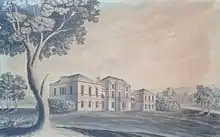Balbardie House
Balbardie House was a country house in West Lothian, Scotland, near the town of Bathgate.
History
Designed by Robert Adam, it has been described as his best classical house in Scotland, the grand manner in miniature.[1] This great neoclassical mansion was demolished in two stages in 1954 and in 1975.[2]

The seat of the Marjoribanks family, since 1624[3] when John Marjoribanks bought the estate,[4] the house was constructed at the end of the 18th century by Alexander Marjoribanks[4] and situated within a park of 100 acres (0.40 km2).[5] One of Adam's final designs, the plans are signed and dated 1792[6] shortly before his death on 3 March 1792.[7] The house is typical of his neoclassical style, with a central corps de logis, flanking wings and end pavilions.[1] The corps de logis had similarities with another of Adam's great houses, Kedleston Hall, except that at Balbardie Adam used a single small pediment at the centre rather than fully suggesting the Arch of Constantine as he did at Kedleston. Another common Adam feature which is highly defined but in an unusual setting at Balbardie are the recessed apses behind screening columns in the low wings connecting the three bayed pavilions to the corps de logis.[6] This was a feature Adam often used internally but seldom externally. That Adam was not present during the final stages of drawing and completion of the house is evident by the prominence of the chimneys at Kedleston and elsewhere so carefully disguised; the pitch of the roofs suggests a northern Baroque such as the Nymphenburg (where the chimneys are equally visible). However, these features are part of the character of the house and should not be seen as detracting from its architectural importance. The house faced South West over gardens which included an ornamental lake, plantations and a belvedere (a summer house with a fine view).[4]
In 1833 Bathgate Academy was built on land called Rules Acre, a part of the Balbardie estate which had been given to the Academy by Alexander Marjoribanks.[4]
The glory of Balbardie as one of Scotland's grandest private houses was to be short-lived - barely sixty years. In 1830 Alexander Marjoribanks died and his estate passed on to his son also called Alexander Marjoribanks. The latter travelled widely and sold Balbardie House to the Edinburgh Merchant Company,[8] trustees of Daniel Stewart's College in 1861.[4] Coal mining began to encroach on the grounds[4] and the house was converted into apartments[8] for miners. The house with the exception of one of the pavilions was demolished in 1954; the remaining pavilion was demolished in 1975. The author Ian Gow described the demolition thus: "the dilapidation and staged demolition of Balbardie.....due to a lack of funding, diminished the heritage of the work of one of Scotland's most celebrated architects, Robert Adam".[7]
Following the demolition of 1975 the land was cleared and landscaped and converted into the Balbardie Park of Peace and Sports Centre[9] which includes the Bathgate Leisure Centre and a golf course.[3][4]
Notes
- Binney, Marcus; Harris, John; and Winnington, Emma (July 1980) "Lost Houses of Scotland" Save Britain's Heritage, Embassy press Ltd., London and Crowborough, East Sussex, ISBN 0-905978-05-6
- "Landmarks wiped off map forever". The Scotsman. 5 November 2006. Retrieved 25 June 2017.
- The Marjoribanks Journal
- "Alexander marjoribanks of Balbardie - Bathgate's Forgotten man", The local Studies Depasrtment, West Lothian District Council Library Services
- British History Online
- King, p 153
- Gow, Ian, "Scotland's Lost Houses" The National Trust for Scotland, Aurum Press, London, 2006, ISBN 1-84513-051-0
- Carson, Callum (1 October 2016). "Memory Lane: Balbardie House and the Marjoribanks family". dailyrecord. Retrieved 25 June 2017.
- Balbardie Park of Peace, Bathgate Archived 5 March 2016 at the Wayback Machine Active Scotland, Retrieved 2 July 2013
References
- British History Online retrieved 25 March 2007
- Gow, Ian (2006). Scotland's Lost Houses. Trafalgar Square. ISBN 1-84513-051-0.
- King, David (2001). The Complete Works of Robert and James Adam. Architectural Press. ISBN 0-7506-4468-0.
- The Marjoribanks Journal, Issue number 2 retrieved 9 August 2010
- Scotland on Sunday, Sun 5 Nov 2006 retrieved 25 March 2007
